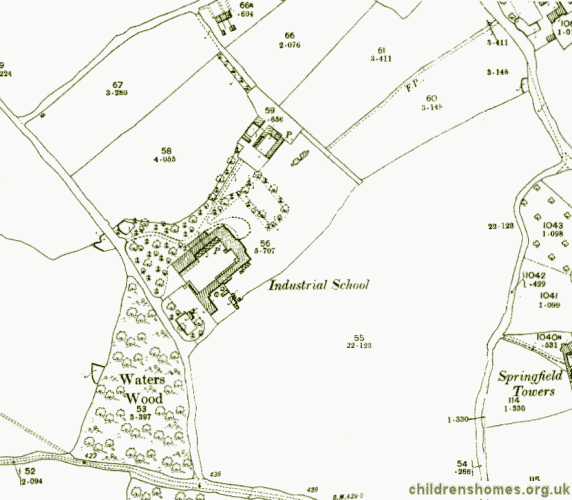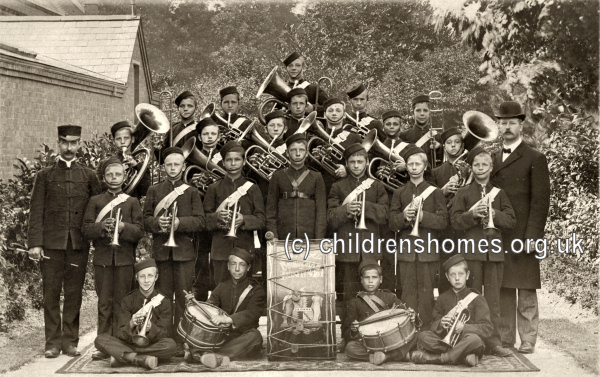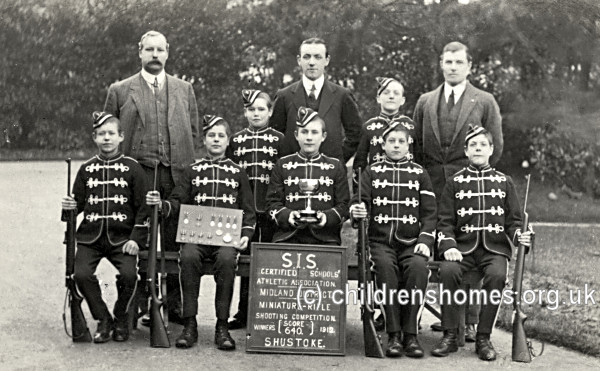Birmingham Town Council Industrial School for Boys, Shustoke, Coleshill, Warwickshire
The Birmingham Town Council Industrial School for Boys was situated in an isolated location on Shawberry (now spelt Shawbury) Lane, Shustoke, Coleshill. It was officially certified to operate as an Industrial School on February 18th, 1868. The School took boys from the Birmingham area who had been sentenced by magistrates to a period of detention.
The School occupied a large old country house known as The Shawberries', together with 45 acres of land taken on a 21-year lease. The first Superintendent was Charles Vinall who had previously been the schoolmaster at the Gem Street Industrial School. His wife, Henrietta, held the post of matron and the Vinall's two daughters, Lucy and Amy, subsequently both became Assistant Matrons.
The School buildings were gradually extended with dormitory wings, workshops, laundry, bakehouse etc. to form a quadrangle. An additional 60 acres of farmland was also acquired adjacent to the School. The School site is shown on the 1903 map below.

Birmingham Town Council Industrial School for Boys site, Shustoke, c.1903.
By the 1880s, Shustoke Industrial School, as it was usually known, could accommodate 150 boys aged from 10 to 14. In addition to their classroom education, the boys were taught trades such as tailoring, shoemaking and baking. Agricultural work and animal husbandry also featured prominently in their training. As well as providing a useful occupation for the boys, the farm work also resulted in a regular supply of vegetables and meat for the School's use.
In 1887, the School staff comprised the Superintendent and Matron (Mr and Mrs F. Forth, the recently appointed successors to the Vinalls), Assistant Matron (Miss Miller), Schoolmaster (Mr W. McColl), Assistant Schoolmaster (Mr T Creers), Farm Bailiff (Mr Seal), tailor, shoemaker, baker/cook, and three labourers. The School had a drum and fife band and a bandmaster visited periodically.

Shustoke Industrial School Boys' Band, early 1900s. © Peter Higginbotham
In the early 1900s, the boys could take up miniature rifle shooting and formed a team which was did well in competitions.

Shustoke Industrial School Rifle Team, 1912. © Peter Higginbotham
A few of the boys each year were sent to Canada where they were taken care of by an employee of the Children's Emigration Home Society.
In 1926, the School was renamed Shawbury School then, in 1933, it became Shawbury Approved School — one of the new institutions introduced by the 1933 Children and Young Persons Act to replace the former Reformatory and Industrial Schools. Shawbury School accommodated 145 Intermediate boys aged from 13 to 15 years. From 1935, Shawbury operated as a short-term Approved School for boys who were judged most likely to benefit from a short training of from six to nine months. The Copeley Hill Hostel in Erdington was also opened in 1935 to provide transitional accommodation for boys moving on from Shawbury.
In 1973, the school became a Community Home with Education (CHE) under the control of Birmingham County Borough Council.
The institutional buildings no longer survive and the site is now occupied by the 'Shawbury Village' housing development.
Records
Note: many repositories impose a closure period of up to 100 years for records identifying individuals. Before travelling a long distance, always check that the records you want to consult will be available.
- Birmingham Archives and Heritage Service, Library of Birmingham, Centenary Square, Broad Street, Birmingham B1 2ND.
Census
Bibliography
- Higginbotham, Peter Children's Homes: A History of Institutional Care for Britain's Young (2017, Pen & Sword)
- Mahood, Linda Policing Gender, Class and Family: Britain, 1850-1940 (1995, Univeristy of Alberta Press)
- Prahms, Wendy Newcastle Ragged and Industrial School (2006, The History Press)
- Higginbotham, Peter Children's Homes: A History of Institutional Care for Britain's Young (2017, Pen & Sword)
- Hyland,Jim Yesterday's Answers: Yesterday's Answers: Development and Decline of Schools for Young Offenders (1993, Whiting and Birch)
- Millham, S, Bullock, R, and Cherrett, P After Grace — Teeth: a comparative study of the residential experience of boys in Approved Schools (1975, Chaucer Publishing)
Links
- None noted at present.
Except where indicated, this page () © Peter Higginbotham. Contents may not be reproduced without permission.


